| |
|
|
|
In 2011 the dacha gardens of Russia produced 40% of the
nation's food.
How much land do you need to grow all your food? This is a dacha garden in Russia where there is a strong tradition of growing your own food.
|
|
|
 |
|
|
|
|
|
| |
|
While many in the world are completely dependent on large scale
agriculture, the Russian people feed themselves. Their
agricultural economy is small scale, predominantly organic and in
the capable hands of the nation's people. Russians have something
built into their DNA that creates the desire to grow their own
food. It's a habit that has fed the Russian nation for centuries.
It's not just a hobby but a massive contribution to Russia's
agriculture. |
|
|
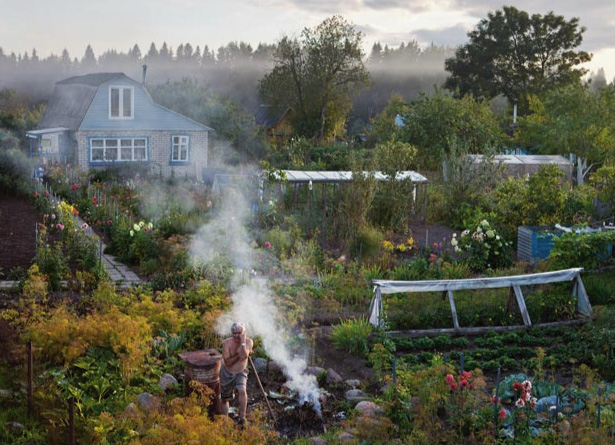 |
|
| |
|
|
|
|
|
| |
|
Sisto-Palkino, Lomonosovsky, Russia |
 |
|
|
| |
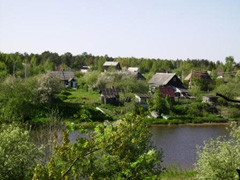 |
|
|
|
40% of Russia's Food is from Dacha Gardens In 2011, 51% of Russia's food was grown either
by dacha communities (40%), like those pictured left in Sisto-Palkino, or peasant farmers (11%) leaving the rest (49%)
of production to the large agricultural enterprises. But when you
dig down into the earthy data from the
Russian Statistics Service you discover some impressive
details. Again in 2011, dacha gardens produced over 80% of the
countries fruit and berries, over 66% of the vegetables, almost
80% of the potatoes and nearly 50% of the nations milk, much of it
consumed raw. While many European governments make
living on a small-holding very difficult, in Russia the opposite
is the case. In the UK
one councillor's opinion regarding living on the land was, "Nobody
would subject themselves to that way of life. You might as well be
in prison"; tell that to a nation of gardeners living off the
land. |
|
|
|
|
|
|
|
During the communist period school
children were obliged to visit their local farms to get
hands-on experience harvesting food (below left) at a time when about 90% of
the nation's food came from dacha gardens. During the same
period every child would be expected to play their part in growing
the family's food from their small patch of Russia.
While the percentage of food grown by Russia's dacha has fallen
since then it is still a massive contribution to the nation's food
and forms an important part of their rural heritage. Take a walk
through the street's of Russia's cities, like St. Petersburg, and
you will find people selling herbs, fruit, berries and vegetables
from their dacha gardens. Unlike many cities in Europe and the
USA, Russian cities are peppered with small corner shops (below
right) selling locally grown food in all shapes, colours and sizes
still carrying their native Russian soil.
If you were to visit a typical Russian dacha you're likely to be greeted
with a welcoming dish called okroshka (below centre), a refreshing cold soup made from home grown cucumber, radish,
spring onion, fresh dill and parsley all swimming in kvas (a home made rye
bread drink) with sour cream or kefir.
More insight:
Food Gardening in the Vladimir Region of Russia by Sharashkin,
University of Missouri–Columbia, MO, USA. |
|
| |
|
|
|
|
|
| |
|
Omsk, Russia |
 |
|
|
| |
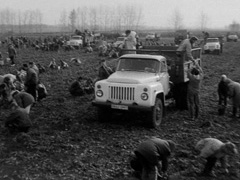 |
|
|
| |
Russian children on a school outing helping
with the harvest some time in the 70s. |
|
|
|
| |
|
|
| |
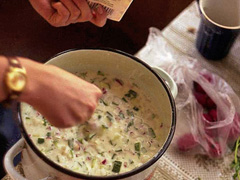 |
|
|
| |
Making okroshka, a typical dish made to
welcome visitors to the dacha. |
|
|
|
| |
|
|
| |
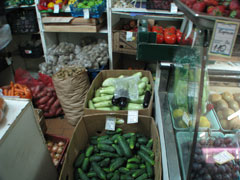 |
|
|
| |
One of the many small city shops selling home
grown food. |
|
|
|
|
|
|
|
|
|
|
Food
sovereignty... Food sovereignty puts the
people who produce, distribute and eat food at the centre
of decisions about food production and policy rather than
corporations and market institutions that have come to dominate
the global food system. In Havana, Cuba 90% of the
city's fresh produce comes from local urban farms and gardens.
In
2003, the Russian government signed the
Private Garden Plot Act into law, entitling citizens to
private plots of land for free. These plots range from 0.89
hectares to 2.75 hectares. Industrial agricultural practices tend
to be extremely resource intensive and can damage the environment.
70% of global water use goes to farming, and soil is eroded 10 to
40 times faster.
|
|
| |
|
The
allotments of central Havana, Cuba |
 |
|
|
| |
|
|
|
| |
Havana has about 200 urban farms known as
organoponicos. |
|
|
|
|
|
|
|
|
|
|
|
|
|
|
|
|
|
|
|